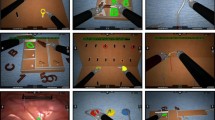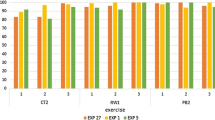Abstract
Background
This prospective study analyzed the effect of different time schedules in training on the main performance outcomes: overall score, time to complete, and economy of motion.
Methods
The study was performed on the da Vinci Skills Simulator from December 2014 to April 2016. Forty robotic novices were randomized into two groups of 20 participants, which trained in the same three exercises but with different intervals between their training sessions. Each group performed training in Peg Board 1 in their first week, Match Board 2 in their second week, and Ring and Rail 2 in their third week. On their last day, Needle Targeting and Energy Dissection 2, for which no previous training had been received, were performed. Regarding the different training intervals, group 1 trained each exercise six times in a row once a week. Group 2 performed their training once a day for 5 days. Technical performance parameters were recorded by the Mimics simulator software for further analysis. In addition, the participants were asked to fill out a questionnaire concerning the robotics training.
Results
Group 2 performed significantly better compared to group 1 in the main metrics in the more advanced exercises. For the easier exercises, the training frequency did not lead to significant differences in performance outcome. A significant skills gain was seen between the first and last training sessions for all exercises in both groups.
Conclusions
Performance in the final exercise NT was significantly better in group 2 than group 1. Regarding ED 2, no difference was found between the two groups. As the training of group 2 led to significantly better outcomes, we suggest that, especially for advanced exercises, it seems to be more favorable to perform training every day for a short period than to train once a week six times in a row.


Similar content being viewed by others
References
Amodeo A, Linares Quevedo A, Joseph JV, Belgrano E, Patel HR (2009) Robotic laparoscopic surgery: cost and training. Minerva Urol E Nefrol Ital. J Urol Nephrol 61:121–128
Meier M, Horton K, John H (2016) Da Vinci© Skills Simulator™: is an early selection of talented console surgeons possible? J Robot Surg 10:289–296
Gomez PP, Willis RE, van Sickle KR (2015) Development of a virtual reality robotic surgical curriculum using the da Vinci Si surgical system. Surg Endosc 29:2171–2179
Meyer M, Gharagozloo F, Tempesta B, Margolis M, Strother E, Christenson D (2012) The learning curve of robotic lobectomy. Int J Med Robot Comput Assist Surg MRCAS 8:448–452
Patel VR, Tully AS, Holmes R, Lindsay J (2005) Robotic radical prostatectomy in the community setting: the learning curve and beyond: initial 200 cases. J Urol 174:269–272
Gallagher AG, Traynor O (2008) Simulation in surgery: opportunity or threat? Ir J Med Sci 177:283–287
Schreuder HW, Wolswjik R, Zweemer RP, Schijven MP, Verheijen RH (2012) Training and learning robotic surgery, time for a more structured approach: a systematic review. BJOG 119:137–149
Mukherjee M, Siu KC, Suh IH, Klutman A, Oleynikov D, Stergiou N (2009) A virtual reality training program for improvement of robotic surgical skills. Stud Health Technol Inform 142:210–214
Abboudi H, Khan MS, Aboumarzouk O, Guru KA, Challacombe B, Dasgupta P, Ahmed K (2013) Current status of validation for robotic surgery simulators: a systematic review. BJU Int 111:194–205
Alzahrani THR, Alkhayal A, Delisle J, Drudi L, Gotlieb W, Fraser S, Bergman S, Bladou F, Andonian S, Anidjar M (2013) Validation of the da Vinci surgical skill simulator across three surgical disciplines: a pilot study. Can Urol Assoc J 7:e520–e529
Hung AJ, Jayaratna IS, Teruya K, Desai MM, Gill IS, Goh AC (2013) Comparative assessment of three standardized robotic surgery training methods. BJU Int 112:864–871
Hung AJ, Zehnder P, Patil MB, Cai J, Ng CK, Aron M, Gill IS, Desai MM (2011) Face, content and construct validity of a novel robotic surgery simulator. Urology 186:1019–1024
Lee JY, Mucksavage P, Kerbl DC, Huynh VB, Etafy M, McDougall EM (2012) Validation study of a virtual reality robotic simulator: role as an assessment tool? J Urol 187:998–1002
Liss MA, Abdelshehid C, Quach S, Lusch A, Graversen J, Landman J, McDougall EM (2012) Validation, correlation, and comparison of the da Vinci trainer and the da Vinci surgical skills simulator using the Mimic software for urologic robotic surgical education. J Endourol 26:1629–1634
Ramos P, Montez J, Tripp A, Ng CK, Gill IS, Hung AJ (2014) Face, content, construct and concurrent validity of dry laboratory exercises for robotic training using a global assessment tool. BJU Int 113:836–842
Moglia A, Ferrari V, Morelli L, Ferrari M, Mosca F, Cuschieri A (2015) A systematic review of virtual reality simulators for robot-assisted surgery. Eur Urol. doi:10.1016/j.eururo.2015.09.021
Kiely DJ, Gotlieb WH, Lau S, Zeng X, Samouelian V, Ramanakumar AV, Zakrzewski H, Brin S, Fraser SA, Korsieporn P, Drudi L, Press JZ (2015) Virtual reality robotic surgery simulation curriculum to teach robotic suturing: a randomized controlled trial. J Robot Surg 9:179–186
Sheth SS, Fader AN, Tergas AI, Kushnir CL, Green IC (2014) Virtual reality robotic surgical simulation: an analysis of gynecology trainees. J Surg Educ 71:125–132
Walliczek-Dworschak U, Mandapathil M, Förtsch A, Teymoortash A, Dworschak P, Werner JA, Güldner C (2016) Structured training on the da Vinci skills simulator leads to improvement in technical performance of robotic novices. Clin Otolaryngol. doi:10.1111/coa.12666
Calatayud D, Arora S, Aggarwal R, Kruglikova I, Schulze S, Funch-Jensen P, Grantcharov T (2010) Warm-up in a virtual reality environment improves performance in the operating room. Ann Surg 251(6):1181–1185
Kahol K, Satava RM, Ferrara J, Smith ML (2009) Effect of short-term pretrial practice on surgical proficiency in simulated environments: a randomized trial of the “preoperative warm-up” effect. J Am Coll Surg 208(2):255–268
Walliczek U, Förtsch A, Dworschak P, Teymoortash A, Mandapathil M, Werner J, Güldner C (2015) Effect of training frequency on the learning curve on the da Vinci skills simulator. Head Neck. doi:10.1002/hed.24312
Tergas AI, Sheth SB, Green IC, Giuntoli RL 2nd, Winder AD, Fader AN (2013) A pilot study of surgical training using a virtual robotic surgery simulator. JSLS 17(2):219–226
Author information
Authors and Affiliations
Corresponding author
Ethics declarations
Disclosures
Drs. Christian Güldner, Annik Orth, Philipp Otto Georg Dworschak, Isabell Diogo, Magis Mandapathil, Afshin Teymoortash, and Ute Walliczek-Dworschak have no conflict of interest or financial ties to disclose.
Rights and permissions
About this article
Cite this article
Güldner, C., Orth, A., Dworschak, P. et al. Evaluation of different time schedules in training with the Da Vinci simulator. Surg Endosc 31, 4118–4125 (2017). https://doi.org/10.1007/s00464-017-5460-x
Received:
Accepted:
Published:
Issue Date:
DOI: https://doi.org/10.1007/s00464-017-5460-x




